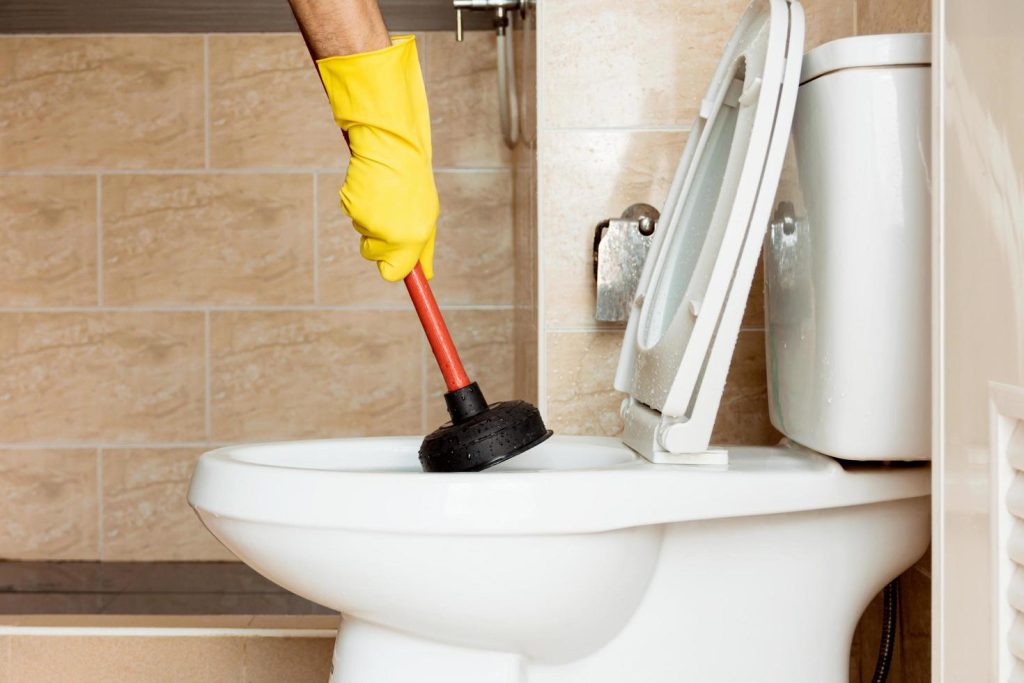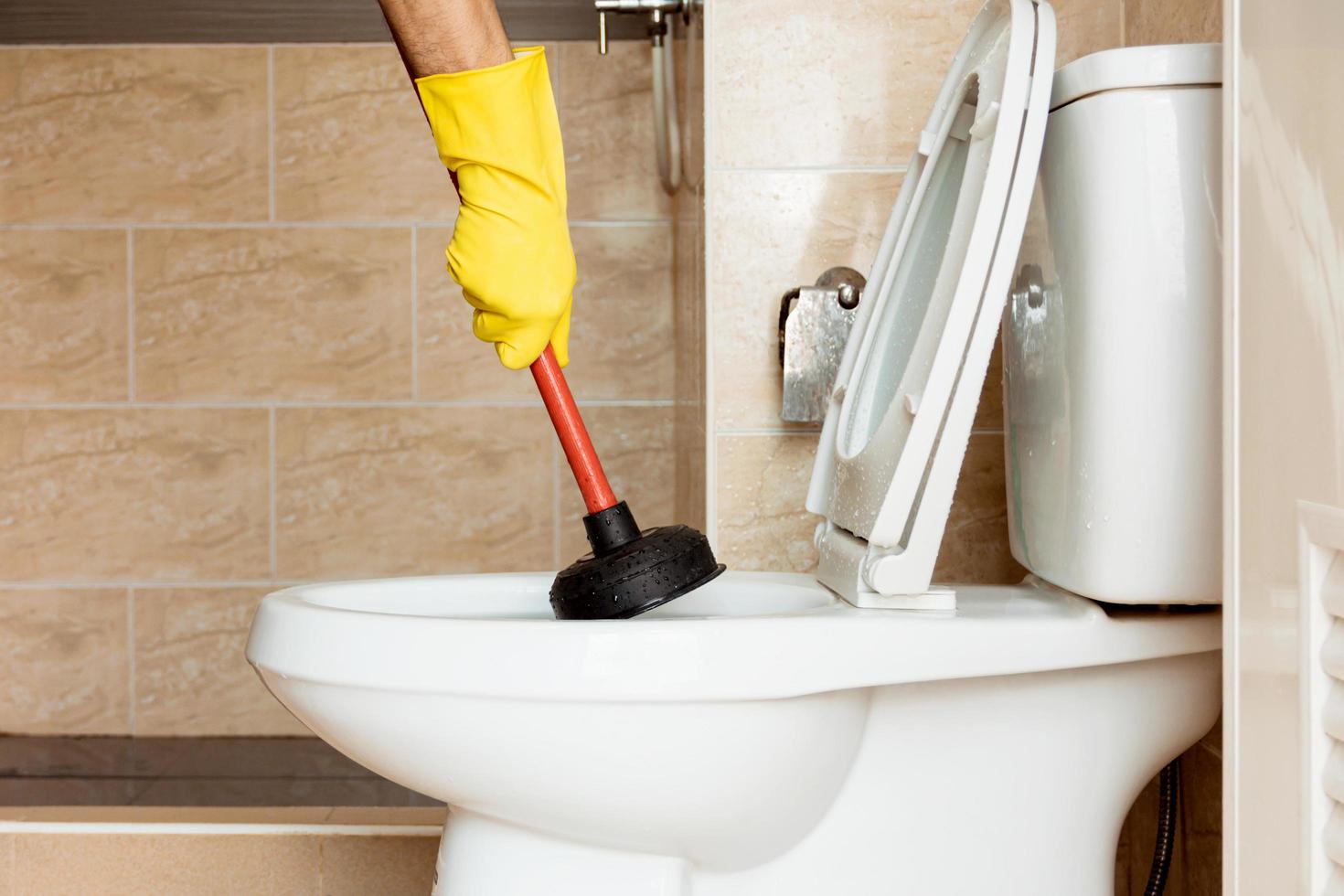Toilet blockages are a common household nuisance. When they happen repeatedly, it could be a sign of a deeper, more serious problem within your plumbing system.

Recurring blockages can indicate issues like a damaged sewer line, tree root intrusion or venting problems. We’ll explore why recurring toilet blockages might mean a bigger issue and how to address them before they escalate into major plumbing problems.
Contents
Common Causes of Toilet Clogs
If your toilets experience frequent blockages, there may be an underlying problem. Understanding the common causes of clogs can help identify whether the problem is a simple fix or a sign of a more serious toilet plumbing issue.
1. Flushing Non-Flushable Items
Some items aren’t designed to break down in water. Wipes, feminine hygiene products, cotton balls, paper towels and even so-called “flushable” wipes can accumulate in the pipes. These items can get caught in bends or rough areas of the plumbing and build up over time. To prevent clogs, remind household members to flush only toilet paper and human waste.
2. Low-Flow Toilet Issues
Low-flow toilets, especially those from the early 1990s, may not provide enough water pressure to fully clear waste with each flush. While these toilets are designed to conserve water, they can sometimes struggle to move materials through the pipes efficiently. If waste doesn’t fully exit the drainage system, it can build up over time and lead to frequent blockages. Upgrading to a more efficient modern model or adjusting the water pressure may alleviate the issue.
3. Buildup in Pipes
Mineral deposits, grease and other debris can accumulate inside pipes and narrow the passageway for waste to flow through. In homes with hard water, mineral buildup from calcium and magnesium can create rough surfaces inside the plumbing, making it easier for waste to get caught and form clogs. If grease, soap scum or small debris make their way into the drain, they can contribute to gradual pipe obstruction. Regular drain cleaning and occasional flushing with hot water and mild cleaning solutions can help prevent buildup from becoming a major problem.
When a Clog Is More Than Just a One-Time Issue
A toilet that repeatedly backs up despite careful flushing habits may be experiencing problems beyond a simple blockage. Ignoring recurring clogs can lead to more serious damage, costly repairs and potential health hazards if wastewater starts backing up into your home.
Some key indicators that a clog is more than just a one-time issue include:
- Multiple slow or clogged drains in the home
- Frequent plunging with little success
- Gurgling sounds or air bubbles
- Sewage odors
- Water backing up in other fixtures
If any of these issues persist, it’s essential to address them promptly. A professional plumber can inspect your toilet plumbing, identify the root cause and recommend the best course of action to prevent further problems.
Possible Bigger Problems Behind Recurring Blockages
If your toilet continues to clog despite careful use and routine plunging, a more significant issue may be lurking within your plumbing system. Recurring blockages can sometimes point to problems beyond the toilet itself.
1. Sewer Line Issues
A major cause of persistent toilet clogs is a blockage or damage in the main sewer line. If waste and water cannot flow freely to the municipal sewer system or septic tank, backups will occur and may affect multiple drains in your home. Sewer line blockages can be caused by grease buildup, accumulated debris or a collapsed or broken pipe. Warning signs include slow-draining fixtures, gurgling sounds and sewage odors coming from drains.
2. Tree Root Intrusion
Tree roots naturally seek moisture, making underground sewer lines a prime target. Over time, small roots can infiltrate cracks or joints in pipes, gradually expanding and creating obstructions that restrict wastewater flow. As the roots grow, they can cause severe blockages, pipe damage and complete sewer line failure. Symptoms of tree root intrusion include frequent clogs, slow drainage and unexplained patches of lush greenery in the yard near sewer lines.
3. Venting Problems
Plumbing vents regulate air pressure in the drainage system and help wastewater flow smoothly. A clogged or blocked vent pipe can create air pressure imbalances that interfere with proper flushing. This can lead to slow-draining toilets, gurgling noises and recurring clogs. If plunging and other clog-clearing methods fail, a blocked vent could be the culprit.
Recurring toilet blockages are often a symptom of a more significant plumbing issue. If your toilet continues to clog despite your best efforts, it’s important to investigate these potential causes before a minor inconvenience turns into a major running toilet repair.
DIY Fixes vs. When to Call a Plumber
While many minor toilet clogs can be handled with a plunger or an auger, there are times when attempting a DIY fix may only worsen the situation. Below is a comparison of common DIY fixes and situations where professional help is required.
| Situation | DIY Fix | Call a Plumber |
| Minor Toilet Clog | Use a plunger or toilet auger to dislodge the blockage. | If plunging doesn’t resolve the issue, or if the clog persists after multiple attempts, contact a plumber. |
| Slow Drain | Try using a natural cleaning solution (baking soda and vinegar) or a drain snake. | If the slow drainage continues throughout the house or is accompanied by gurgling sounds, it could indicate a deeper problem. |
| Frequent Clogs | Use a plunger and check for simple obstructions in the toilet bowl. | If clogs happen regularly, it could signal a larger issue like a sewer line problem or tree root intrusion. |
| Backed-Up Toilet | Try to clear the clog with a toilet auger or plunger. | If the toilet backs up repeatedly, or if it affects other drains, a sewer line inspection may be necessary. |
| Bad Odors or Gurgling Noises | Ensure the vent stack is clear of debris and check for any obstructions in the toilet bowl. | If venting issues are suspected, or if odors persist despite cleaning, a plumber can inspect and resolve the problem. |
How to Prevent Future Blockages
Preventing future toilet blockages involves developing good flushing habits and keeping up with regular maintenance. The most important practice is to flush only toilet paper and human waste. Avoid flushing items like wipes, cotton balls, paper towels and hygiene products. Educate all household members, including children, on what should and should not be flushed to prevent accidental obstructions.
Periodically inspect your toilet and plumbing to check for signs of buildup or minor clogs. Clean your toilets and drains with a mild, nonabrasive cleaner to prevent debris from accumulating. Flush hot water through the pipes from time to time to clear away any buildup of soap scum, grease or other residue. If you live in an area with hard water, use a water softener to reduce mineral deposits.
Routine inspection of the toilet’s inner mechanisms is also important. Ensure that the flapper valve and flush valve are functioning properly to avoid any issues with flushing performance. If you notice that your toilet struggles to flush or requires multiple attempts, it may be time to investigate further and make repairs before a clog becomes inevitable.
Handle and Prevent Clogs Like a Pro
Recurring toilet blockages often signal underlying problems that need to be addressed. While occasional clogs are normal, frequent blockages could indicate larger plumbing concerns. Regular maintenance and proactive care can keep your plumbing system functioning smoothly. If you find yourself dealing with persistent clogs or other plumbing issues, know when to seek professional help to prevent costly repairs.

